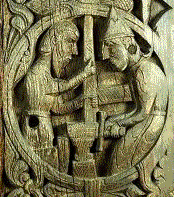 Live
Issues in Saga-Forschung I
Live
Issues in Saga-Forschung I
 Live
Issues in Saga-Forschung I
Live
Issues in Saga-Forschung I
LIVE ISSUES IN SAGA-FORSCHUNG I
1, Bibliography:
a. Islandica I (1908), XXV (1935), XXVIII (1957), The Sagas of the
Icelanders. To this, the basic bibliography, add the periodical
bibliographies of BONIS, KHL, ANF, APS, PMLA, YWMLS, etc. etc.
b. The standard histories of literature: Jonsson, Mogk, Helgason,
de Vries, Turville-Petre, Simek and Palsson.
c. Bertha S. Phillpotts, Edda & Saga (1931); Einar O. Sveinsson,
Les sagas islandaises (Paris, 1961); P. Hallberg, Den isl sagan
(Stockholm, 1959), transl. into English by Paul Schach as: The
Icelandic Saga (U. of Nebraska Press, 1962); W. A. Craigie, The
Icelandic Sagas (Cambridge, 1913); Halvdan Koht, The Old Norse
Sagas (NY, 1931); Sigurdur Nordal, Sagalitteraturen (Reykjavik,
1953); Theodore M. Anderson, The Problem of Icelandic Saga Origins:
A Historical Survey (Yale Germanic Studies I, 1964); M. Scovazzi,
La saga di Hrafnkell e il problema delle saghe islandese (Brescia,
1960); Theodore M. Anderson, The Icelandic Family Saga: An Analytic
Reading (Cambridge, 1967); M. I. Steblin-Kamenskij, The Saga Mind,
trasl. by our own Kenneth H. Ober (Odense University Press, 1973).
2. Free Prose, Book Prose. Paul Schacch in The Medieval Literature
of Western Europe, ed. John H. Fisher (MLA, 1966), 204: "The
proponents of this doctrine (Heusler, Schneider, Jonsson, Liesto/l,
and their disciples), with individual variations, subscribe to most
or all of the following postulates: (1) the sagas of native heroes
were independent of the general literary development of Iceland and
of Europe (1100-1400; (2) their artistic excellence precludes the
possibility of individual authorship; (3) these stories arose and
assumed fixed form contemporaneously with the events they relate;
(4) they must therefore contain much historical truth; (5) the
articulated sagaas were memorized and orally transmitted for
centuries, with a gradual refinement in style and diction; (6) "das
Pergament faengt die gehoerte Sprache des Geschichtenmannes mit der
Treue des Phonographen auf" (Heusler); (7) motival and verbal
similarities between sagas steem from a common tradition; (8)
textual variants result from a cleavage in tradition before its
solidification." The strongest example of this view is that of K.
Liesto/l, Upphavet til den islandske aettesaga (Oslo, 1929),
transl. Engl. The Origin of the Icelandic Family Sagas (1930). The
book prose theory holds that the Icelandic saga represents
sophisticateed fiction or literary tradition. The strongest
proponent of this view is W. Baetke, Ueber die Entstehung der
Islaendersagas (Berlin, 1956).
3. Historicity. As you see, the tradition has been to believe that
the sagas are actually telling historical stories, with more or
less truth to them. Finnur Jonsson said: "I will maintain and
defendd the sagas' historical trustworthiness -- no matter how
`grand' this may sound -- until I am forced to lay down my pen"
(Norsk-Islandske Kultur, 141). He and Heusler are perhaps the best
known proponents of absolute historicity. Opponents are Konrad
Maurer and W. Baetke, whereas Liesto/l may be held to represent a
middle ground, while leaning towards historicity. Those who
believe in free-prose tend to believe in historicity. The question
is moot at the moment, and there is little agreement even on basic
approaches to the problem.
4. Thattr Theory. This is comparable to the Liedertheorie applied
to other Germanic literatures, to Wilhelm Schlegel's theory of the
composition of Homer, and to NT form criticism. The classical
form
of the theory is that of A. U. Baath, Studier oefver Kompositionen
i naagra islaendska Aettasagor (Lund, 1885). Here it was maintained
that the sagas consisted of smaller episodes (thaettir `strands')
woven together. He was opposed by Heusler, but his theory has been
upheld by W. H. Vogt (ZfdA 38, 1920, 161-204) and recently by W.
Lange, "Einige Bemerkungen zur altnordischen Novelle," ZfdA 88
(1957), 150-59, and others.
5. Irish Hypothesis. "By the Irish hypothesis is meant a view ...
according to which the roots of the Icelandic saga grew in the soil
of Irish storytelling (Anderson, 56)." Its strongest proponent was
Sophus Bugge; opponents were Heusler and Finnur Jonsson. It
presentday proponent (pace Anderson, who believes the issue is
dead) is J. Carney, Studies in Irish Liteerature and History
(Dublin, 1955). There is a bibliography (incomplete) of Irish-
Scandinavian relations in Medieval Scandinavia.
6. Literary Criticism and Style:
a. Margaret Jeffrey, The Discourse in Seven Icelandic Sagas (1934).
b. Margaret Haeckel, Die Darstellung und Funktion des Traumes in
der islaendischen Familiensaga (1934); Georgia D. Kelchner, Dreams
in Old Norse Liteerature and their Affinities in Folklore (1935);
cf. Gabriel Turville-Petre, "Dreams in Icelandic Tradition,"
Folklore 69 (1958), 93-111; Paul Schach, "Some Parallels to the
Tree Dream in Ruodlieb," Monatshefte 46 (1954), 353-364.
c. Return to a above: W. Ludwig, Untersuchungen ueber den
Entwicklungsgand und die Funktion des Dialogs in der islaendischen
Saga (1934).
d. A. Goedecke, Die Darstellung der Gemuetsbewegungen in der
islaendischen Familien-Saga (1933); H. J. Graf, Untersuchungen zur
Gebaerde in der Islendingasaga (1938).
e. Paul Schach, "The Anticipatory Literary Setting in the Old
Icelandic Sagas," Scandinavian Studies 27 (1955), 1-13. On the use
of natural settings.
f. W. Lehmann, Das praesens historicum und praeteritum in der
altislaendischen Saga (1951); P. M. Morris, Das Futurum in den
altislaendischen Familiensagen (Munich, 1964); M. C. van den Toor,
"Zeit und Tempus in der Saga," ANF 76 (1961), 134-52.
g. G. Loescher, Gestalt und Funktion der Vorausdeutung in der isl.
Saga-Literatur (Tuebingen, 1956), on prolepsis; W. Wirth, Der
Schicksalsglaube in den I-s (Stuttgart, 1940). See also Baath,
above, section 4, on prolepsis.
Some Links: (Added by Stephen Carey)